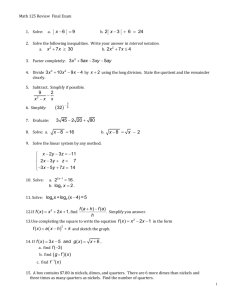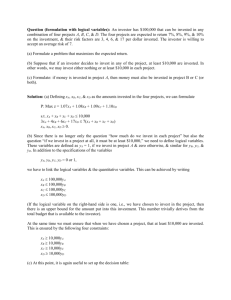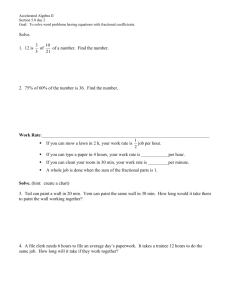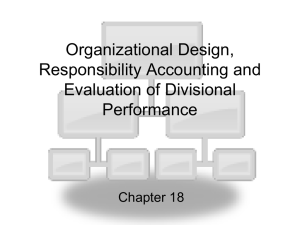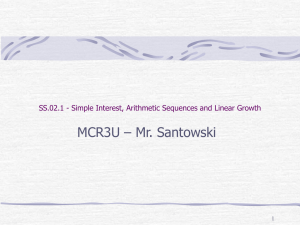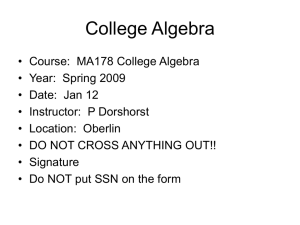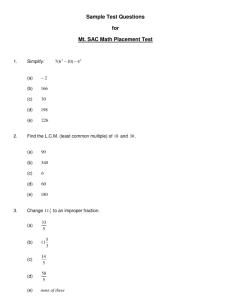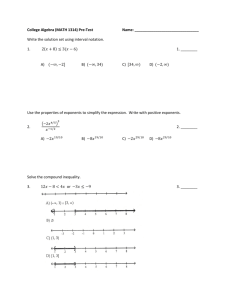MATH 101 FINAL EXAM Review College Algebra
advertisement
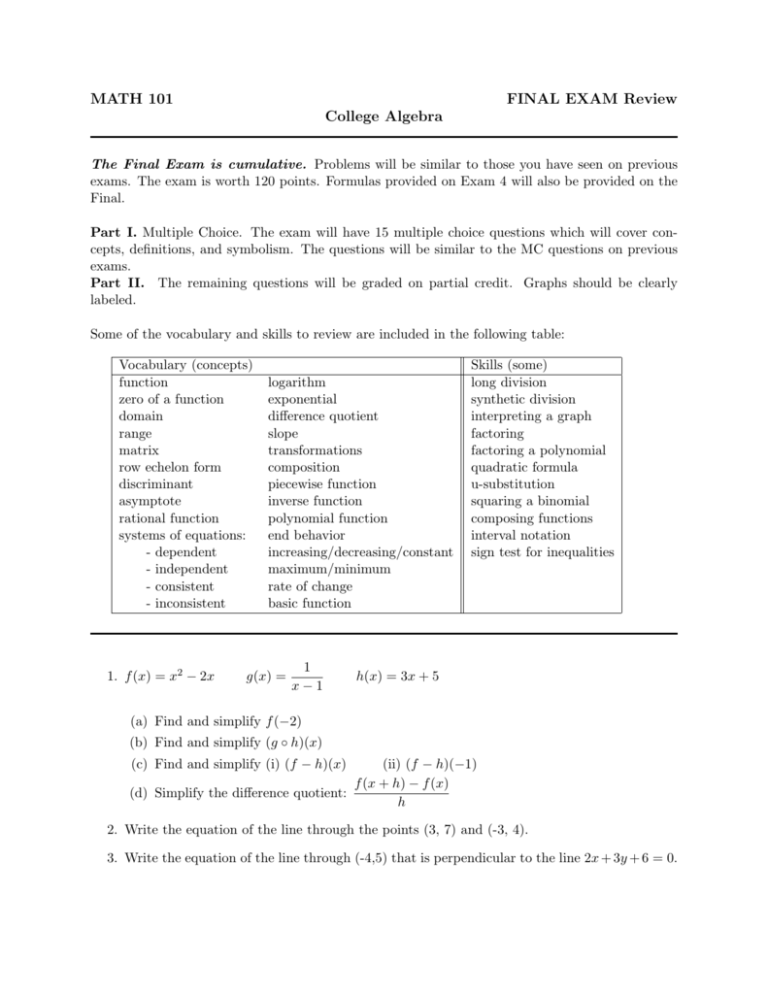
MATH 101
FINAL EXAM Review
College Algebra
The Final Exam is cumulative. Problems will be similar to those you have seen on previous
exams. The exam is worth 120 points. Formulas provided on Exam 4 will also be provided on the
Final.
Part I. Multiple Choice. The exam will have 15 multiple choice questions which will cover concepts, definitions, and symbolism. The questions will be similar to the MC questions on previous
exams.
Part II. The remaining questions will be graded on partial credit. Graphs should be clearly
labeled.
Some of the vocabulary and skills to review are included in the following table:
Vocabulary (concepts)
function
zero of a function
domain
range
matrix
row echelon form
discriminant
asymptote
rational function
systems of equations:
- dependent
- independent
- consistent
- inconsistent
1. f (x) = x2 − 2x
logarithm
exponential
difference quotient
slope
transformations
composition
piecewise function
inverse function
polynomial function
end behavior
increasing/decreasing/constant
maximum/minimum
rate of change
basic function
g(x) =
1
x−1
Skills (some)
long division
synthetic division
interpreting a graph
factoring
factoring a polynomial
quadratic formula
u-substitution
squaring a binomial
composing functions
interval notation
sign test for inequalities
h(x) = 3x + 5
(a) Find and simplify f (−2)
(b) Find and simplify (g ◦ h)(x)
(c) Find and simplify (i) (f − h)(x)
(ii) (f − h)(−1)
f (x + h) − f (x)
(d) Simplify the difference quotient:
h
2. Write the equation of the line through the points (3, 7) and (-3, 4).
3. Write the equation of the line through (-4,5) that is perpendicular to the line 2x + 3y + 6 = 0.
!
4. Describe each transformation. Use the graph of y = f (x) given to sketch each transformation.
(a) y = f (x − 1) + 2
(b) y = 12 f (x)
(c) y = −f (x)
Math 101 Exam Final
Grading Guide
Fall 2011
61. MC::Function::Substitution (V: 0)
( a ) (2 points)
5. Graph
the piecewise function:
(2 points) Iff(x) = 3x + 22, then f(x + h) =
(x + 2) −3 ≤ x < 0
fa)(x)
=
3x + 3h + 2−2x
b) x
3x <
+ 2h
0≤
2
c) 3x + 2 + 3h + 2
d) 3x + 2 + h
62. MC::Function::Substitution (V: 1)
( d ) (2 points)
(2 points) If f(x) = x2 , then f(x + h) =
a) x2 + h2
b) x2 + h
c) x3 + x2 h
d) x2 + 2xh + h2
63. Graphing::IntersectingFunctions::Inequality (V: 0) (randomization)
(3 points) Use the following figure to find the value(s) of x for
which f(x) < g(x).
6. Use the graph to solve f (x) < g(x)
10
f(x)
8
6
4
2
0
−10 −8 −6 −4 −2 0
−2
−4
−6
−8
−10
2
4
6
8 10
g(x)
{x|x < −1} or (−∞, −1) (3 points)
7. Graph the function f (x) = x2 + 2x − 6. [Label the scale clearly.]
(a) What is the vertex?
(b) Over what interval(s) is f (x) increasing?
(c) Over what interval(s) is f (x) decreasing?
(d) Find the real zero(s) for f (x).
8. A cell phone company develops a pay-as-you-go cell phone plan in which the monthly cost
varies directly as the number of minutes used. If the company charges $17.70 in a month
when 236 minutes are used, what is the constant of variation? What should it charge for a
month in which 500 minutes are used?
9. Demand for a product varies inversely with the price per unit of the product. Demand for the
product is 10,000 units when the price is $5.75 per unit. What is the constant of variation?
What is the demand (to the nearest hundred units) when the price is $6.50?
10. The profit that a vendor makes per day by selling x pretzels is given by the function
P (x) = −0.002x2 + 2.8x − 200. Find the number of pretzels that must be sold to maximize
profit.
11. The height of a model rocket launched from a 112 foot cliff is given by h(t) = −16t2 +96t+112,
where t is the time, in seconds, from when the rocket is launched. Find the maximum height
the rocket attains above the cliff.
12. Decide whether (x + 4) is a factor of P (x) = 2x3 + 14x2 + 23x − 4.
13. Describe the end behavior of the graph of f (x) = −x4 + 2x + 5
14. For the polynomial function P (x) = (x2 − 3)(x − 2)(x + 1)2 , list all the zeros and their
multiplicities. Determine whether the graph of P (x) touches or crosses at each zero.
15. Factor f (x) = 3x3 + x2 − 34x + 40 into linear factors given that 2 is a zero of f (x).
16. Use the Rational Zeros Theorem to list the possible rational zeros for f (x) = 10x3 − 13x2 −
103x − 20.
17. Give the equations for any vertical, horizontal, or oblique asymptotes of
3x2 − 4x + 5
2x + 3
x2 − x − 2
(b) g(x) =
(c) h(x) = 2
(a) f (x) = 2
2x − x − 21
x−2
x − 2x − 3
18. Sketch a graph of f (x) =
2x − 3
. Label all intercepts and asymptotes.
x+1
19. Solve each inequality analytically (sign test). Verify graphically.
(x − 2)(x + 1)
≤0
(b) x2 − 5x + 4 < 0
(a)
(x + 4)
20. Find a formula for the inverse of f (x) =
√
x−3
(a) What is the domain for f (x)?
(b) What is the domain for f −1 (x)?
21.
(a) Write in logarithmic form: 2−3 = 0.125
(b) Evaluate: log7 28
(c) Evaluate: ln e3.6
22. Solve for x: log2 (6x − 4) = 4.1
23. Solve for x: 42x−5 =
1
64
24. Solve for x: 2x−3 = 72x
25. Solve for x: e5x−1 = 4
26. Solve for x: 3x2 − 2x + 11 = 0
27. Solve for x: |4x − 3| = 9
28. Use the properties of logarithms to express the following as a sum, difference, or product of
m3 n
simpler logarithms: log √
y
29. Suppose $15,000 is invested at 3.25%. Find the total amount present at the end of 5 years if
interest is compounded
(a) quarterly
(b) continuously
30. If Tim has $1000 to invest at 7% compounded continuously, how long will it be before he has
$1500? How long before his investment is doubled?
31. If Seattle had a population of 2.3 million in 1990 and 1.75 million in 1950, use the continuous
growth model A(t) = A0 ekt to find the rate of growth and predict the population for 2015.
32. The radioactive isotope of potassium 42 K which is used in the diagnosis of brain tumors, has
a half-life of 12.4 hours. If 500 milligrams are taken, how many milligrams will remain after
24 hours?
33. A sheet of heavy-duty cardboard measuring 40 inches by 30 inches is to be made into an open
box by cutting out equal-sized squares of side length x from each corner and folding up the
sides.
a) What are the restrictions on the values for x?
b) Write a function V , which will give the volume of the open box.
c) Find the volume if a square that is 4.5 inches on a side is cut out.
d) For what value of x will the volume be a maximum? What is the maximum volume?
34. Solve the following linear systems by substitution, elimination, or matrix row operations.
6x + 3y = 12
2x + 3y = 27
(a)
(b)
2x − y = −2
y − x = −1
(c)
− 2y = 1
5x − 30y = 18
(e)
x + 14 y = 7
8x + 2y = 56
1
3x
x + 2y + 4z = −3
2x + 7y + 15z = −12
(d)
4x + 7y + 13z = −10
35. The given matrix represents a linear system. Write the solution to the system.
1 4 −3 8
0 −2 1 6
0 0
0 0
36. Write the augmented matrix for the linear system below. Then, perform the indicated row
operations
(in order) to transform the matrix.
2x − y + 3z = 0
x + 2y − z = 5
2y + z = 1
a) R1 ↔ R2
b) 2R2 + R3 −→ R3
37. Set up a system of equations to solve. Then solve by substitution, elimination, or matrix row
operations.
An inheritance of $5,000 is divided among three investments yielding $240 in simple interest
per year. The interest rates for the investments are 3%, 4%, and 6%. The difference in the
amount of money invested in the fund paying 6% and the amount invested for the least return
is the same as the amount invested at 4%. Find the amount of each investment.
Answers:
1. (a) 8
(b)
2. y = 12 x +
1
3x + 4
(c) (i) x2 − 5x − 5 (i) 1
11
2
3. y = 32 x + 11
4.
(d) 2x + h − 2
4
!
2
! (a) The new graph is shifted 1 unit right and 2 units up. Key points:
(-1, 0), (1, 4), (3, 0)
!
!
4
0
(b) The new graph is a vertical shrink by a factor of 12 . Key points:
(-2, -1), (0, 1), (2, -1)
!
-4
-2
0
2
4
! new graph is reflected over the x-axis. Key points: (-2, -22), (0, -2),2 (2, 2).
(c) The
!
5. open circle on (0,4) and (2,-4)
!
-4
-4
0
-2
0
2
4
6
-2
4
-4
2
0
-6
-4
-2
6
0
2
-2
2
-6
-6
!
0
-4
-2
0
-2
6. (−∞, −1)
-4
!
7.
-6
!
(a) (-1, -7)
(b) [−1, ∞)
!
(c) (−∞, −1]
!
(d) x = −1 ±
6
4
-4
!
4
√
7
2
4
6
8. k = $.075 charge per minute; $37.50
9. k = 57, 500; ≈ 8800 units
10. 700 pretzels
11. maximum height above the cliff: 144 feet
12. yes; P (−4) = 0
13. falls on the left (as x → −∞, f (x) → −∞); falls on the right (as x → ∞, f (x) → −∞)
√
14. crosses at x = ± 3, 2 (each multiplicity 1) and touches at x = −1 (multiplicity 2)
15. f (x) = 3(x − 2)(x + 4)(x − 53 ) or f (x) = (x − 2)(x + 4)(3x − 5)
1 2 4 5
16. ±{1, 2, 4, 5, 10, 20, 21 , 51 , 10
, 5, 5, 2}
17.
(a)
VA: x = 27 , x = −3
HA: y = 12
OA: none
(b)
VA: x = 2
HA: none
OA: y = 3x + 2
(c)
VA: x = 3, x = −1
HA: y = 0
OA: none
18.
VA: x = −1
HA: y = 2
y-int: (0, -3)
x-int: ( 32 , 0)
4
!
!
19.
!
critical
! values:
test intervals:
work:
answer:
2
(a)
2, -1, -4
(−∞, −4), (−4, −1),
(−1, 2), (2, ∞)
show tests
(−∞, −4) ∪ [−1, 2]
20. f −1 (x) = (x + 3)2 , x ≥ −3
21. (a) log2 0.125 = −3
(b)
-4
-2
1, 4
(−∞, 1), (1, 4), (4, ∞)
0
2
4
-2
-4
(1, 4)
6
(a) Domainf : [0, ∞)
(b) 1.712
0
(b) Domainf −1 : [−3, ∞)
4
(c) 3.6
2
0
-6
-4
-2
0
-2
-4
!
-6
2
4
6
22. x ≈ 3.525
23. x = 1
24. x =
3 log2
≈ −0.65
log2 − 2 log7
ln4 + 1
≈ .477
5
√
1 ± 4i 2
26. x =
3
25. x =
27. x = 3 and x = − 32
28. 3 log m + log n −
1
2
29. (a) $17,635.14
log y
(b) $17,646.72
30. 5.79 years; 9.9 years
2.3
ln 1.75
31. k =
; 2.73 million people in 2015
40
32. k =
ln(.5)
≈ −.0559; 130.7 milligrams remain after 24 hours
12.4
33. a) 0 < x < 15
b) V (x) = (40 − 2x)(30 − 2x)x = 1200x − 140x2 + 4x3
d) x ≈ 5.7in., V (5.7) ≈ 3032.2 cu.in.
34.
(a) ( 21 , 3)
(c) ∅
(e) (7 − 41 y, y)
c) 2929.5 cu.in.
((b) (6, 5)
(d) (1, -2, 0)
35. (z + 20, 21 z − 3, z)
36.
37.
augmented matrix
2 −1 3 | 0
1 2 −1 | 5
0 2
1 | 1
(a)
1 2 −1 | 5
−→ 2 −1 3 | 0
0 2
1 | 1
x = $ invested at 3%
y = $ invested at 4%
z = $ invested at 6%
x + y + z = 5000
.03x + .04y + .06z = 240
z−x=y
x = $1000, y = $1500, z = $2500
(b)
1 2 −1 | 5
−→ 2 −1 3 | 0
4 0
7 | 1
